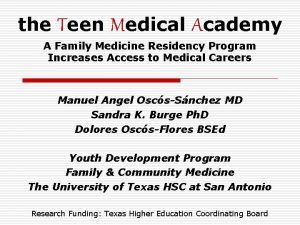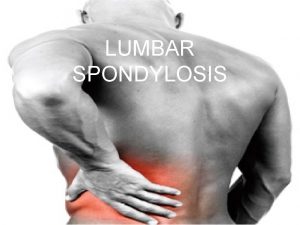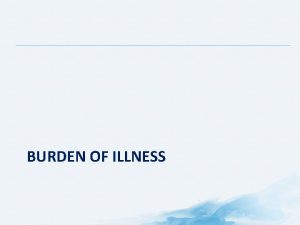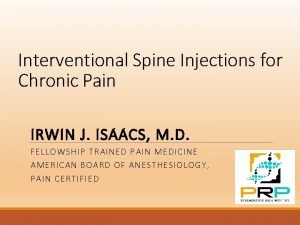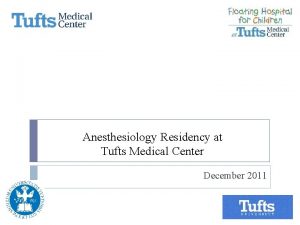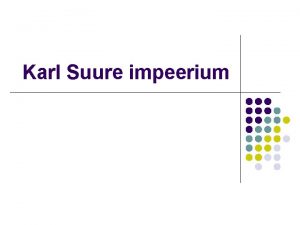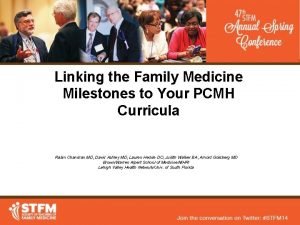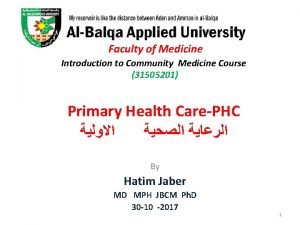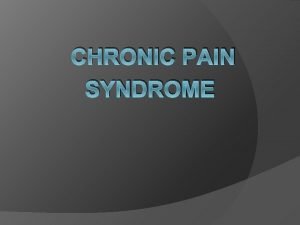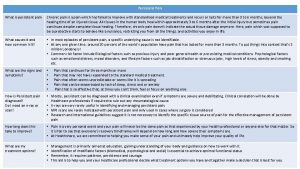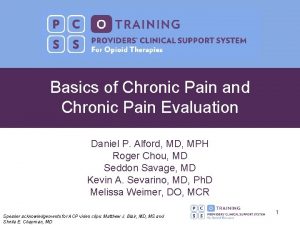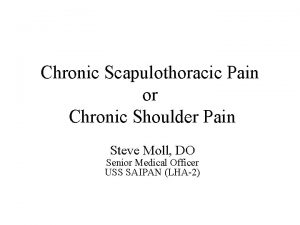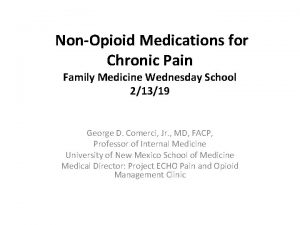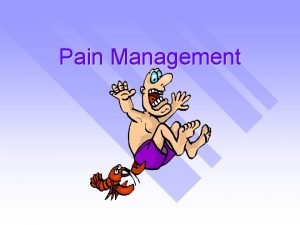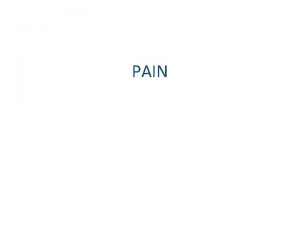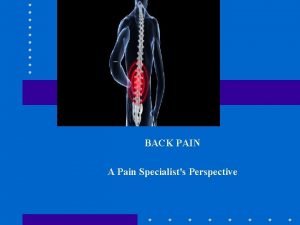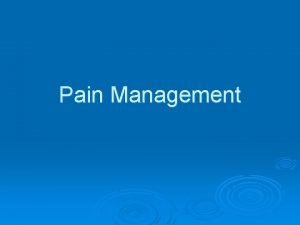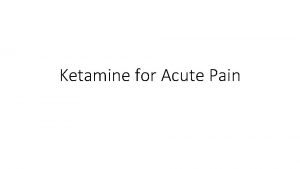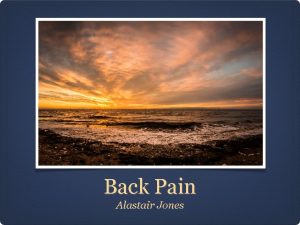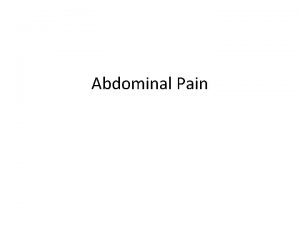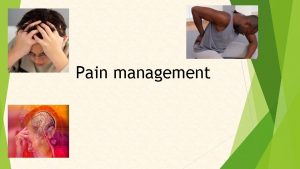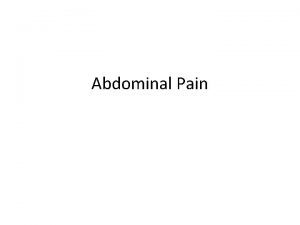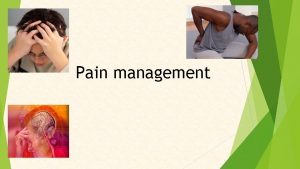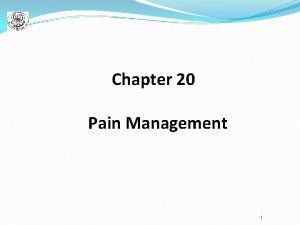Preparing Family Medicine Residents for Managing Chronic Pain































- Slides: 31

Preparing Family Medicine Residents for Managing Chronic Pain Laura Hempstead, DO, FACOFP Miranda Huffman, MD, MEd 4/26/15

Disclosures • None

Objectives u. Use opioid risk tools, chronic pain management agreements, and selfmanagement tools to care for chronic pain patients u. Implement a chronic pain management program in a residency clinic u. Utilize the electronic health record to improve care of the patient with chronic pain

Obstacles to treating Pain with Opioids • Physicians and NP’s are not adequately educated in pain management • Physicians fear legal issues (56%), are concerned about causing their patients to become addicted (63%), and fear that the medications will be diverted and sold as street drugs • 52% of physicians cite difficulty monitoring patients as a barrier to pain management • 66% cite difficulty differentiating tolerance to opioids and addiction as a barrier

Federation of State Medical Boards Model Policy – Our responsibilities • In 1998 Model Guidelines for Use of Controlled Substances for the Treatment of Pain was issued by the Federation of State Medical Boards • Pain management is integral to quality medical care • Opioid analgesics for all types of pain may be essential for relief • Inappropriate pain management includes nontreatment, undertreatment, overtreatment and the continuation of ineffective treatment • Physicians are not to be penalized solely for prescribing opiates in the legitimate course of care • Physicians should reduce the potential for diversion

Educational tools Provide a step-wise evaluation and treatment strategy: • Clinical note template which guides the physician along appropriate evaluation and monitoring guidelines • Opioid risk tool use prior to opioid prescription • Controlled substances agreement form • Patient self-management tools

Goals of pain therapy – assessed in initial pain management note • Enhance function, motivation and self-reliance • Reduce pain and help patient set realistic goal for level of pain and function • Encourage recognition of factors that contribute to pain and establish realistic goals and proactive strategies of dealing with pain and pain triggers • Enhance psychosocial well-being • Minimize adverse outcomes and costs • Minimize side effects • Minimize aberrant drug-taking and addiction

The Four A’s of Treatment Outcomes – embedded into follow-up notes • Analgesia – pain relief • Activities of daily living – psychosocial functioning • Adverse effects – side effects • Aberrant drug taking – compliance, addiction-related outcomes, pseudoaddiction

Universal Precautions in Pain Management • Adequate H&P including psychosocial assessment • Treatment agreement if prescribing narcotics • Pre- and Post-intervention assessment of pain score and functional level • Document everything! • Regularly assess the 4 A’s • Appropriate trial of adjunctive medications and opioids if necessary • Periodic UDS if treating with opioids

Medication Management – general principles • Start with topical or non-narcotic OTC agents • Use anti-inflammatory medications if applicable • Choose adjuvants (TCA’s, anticonvulsants) based on side effect profile and underlying pain mechanism • Add Tramadol if no seizure history • Add narcotic if pain is not controlled with above measures, PT etc.

Opioid agreement • Contract with patient that they will only receive medications from you, only use one pharmacy, keep all appointments and agree to random urine drug testing

Opioid Risk Tool • Assesses Family and personal history of substance abuse • Age • History of prior sexual abuse • Psychiatric history • Places patients in risk categories • Provides monitoring guidelines for each category


Opioid Initial Visit Chart Note • Provides one place to document all information needed to monitor patient’s pain progress, including pertinent H&P information, documentation of 4 A’s and opioid agreement • Provides all relevant information needed regarding prior medications tried (useful for prior authorization requests) • Labeled as a specific note type for easy reference


Summary of 3 hour education given to residents • Pain is one of the most common conditions you will treat • Pain is modified by numerous chemical factors (substance P, Glutamate, 5 HT, NE, NO, etc) affecting sodium, calcium and potassium influx into cells at the peripheral, spinal cord and central levels • Obtain and accurate and thorough H&P

Summary (cont. ) • Set realistic treatment goals with the patient • Monitor the 4 A’s of treatment (analgesia, ADL’s, adverse effects, aberrant behaviors) • Begin with physical modalities and OTC meds • Add adjuvant meds such as TCA’s, anticonvulsants and muscle relaxers • Obtain narcotics agreement • Manage medication side effects

Summary of Treatment tools • 3 hour didactic on chronic pain presented to 1 st year residents • Opioid Risk Tool - ad hoc form in EMR • Initial Pain Management visit note – insures complete history taken and guides treatment choices • Follow-up visit note insures monitoring guidelines are followed • Patient Education Self-management tool given as part of patient depart process encourages goal-setting with patients and promotes PCMH principles

Internet resources for prescribing guidelines and safeguards • • • www. jcaho. org www. ampainsoc. org American Pain Society www. painmed. org American Academy of Pain Medicine www. nccn. org National Cancer Care Network http: //www. deadiversion. usdoj. gov DEA summary of prescribing law • http: //www. gpoaccess. gov Code of Federal Regulations • www. fsmb. org Federation of State Medical Boards

But does it work? • Surveyed primary care residents from nine residency programs using an online survey to assess: – Resident comfort with managing chronic pain patients – Their current use of these tools

Survey • • Sent September 2013 and April 2014 Distributed by e-mail with 2 reminder e-mails Data collected using Survey. Monkey Total of 109 surveys analyzed – 84 responded 9/13, 48 responded 4/14 – 6 incomplete responses – 16 responded to both surveys – analyzed only follow-up survey

n (%) PGY 1 PGY 2 PGY 3 43 (40) 32 (30) 33 (31) Male Female 46 (43) 62 (57) Mayo FMR Research FMR Southern New Mexico FMR UMKC IMR UMKC Med. Peds Residency Univ of Cincinnati FMR Univ of Colorado FMR Univ of North Carolina FMR 12 (11) 8 (7) 1 (1) 38 (35) 12 (11) 2 (2) 10 (9) 15 (14) 10 (9)

Methods • Responses were analyzed using a twosample t-test with a two-sided alpha level of 0. 05. • On questions using a five-point Likert scale, we assigned linear numbers to categorical responses (strongly disagree=1; strongly agree=5).

Resident Comfort with Managing Chronic Pain Patients n (%) Strongly disagree 8 (7) Disagree 42 (39) Neutral 36 (33) Agree 21 (19) Strongly agree 1 (1) Mean 2. 7 (SD 0. 9)

Mean comfort with managing chronic pain patients Change in comfort with tool usage (CI) Use of a controlled substance agreement Yes (n=17) No (n=91) 2. 8 2. 1 0. 73 (0. 28 -1. 19) Use of opioid risk tool Yes (n=33) No (n=75) 3. 0 2. 6 0. 42 (0. 06 -0. 79) Use of patient selfmanagement forms Yes (n=25) No (n=83) 3. 0 2. 6 0. 47 (0. 07 -0. 88) Use of routine urine drug screening Yes (n=73) No (n=35) 2. 9 2. 2 0. 70 (0. 36 -1. 05) Use of a prescription monitoring program Yes (n=72) No (n=36) 2. 8 2. 5 0. 22 (0. 14 -0. 59)

Tool Mean (SD) of residents who use the tool Mean (SD) of Difference (CI) residents who do not use the tool P-value Opioid risk tool 3. 9 (0. 72) 3. 6 (0. 76) 0. 35 (0. 04 -0. 66) 0. 03 Controlled substance agreement 4. 4 (0. 60) 3. 7 (1. 21) 0. 70 (0. 32 -1. 08) 0. 001 Patient selfmanagement form 3. 7 (0. 68) 3. 4 (0. 84) 0. 31 (-0. 06 -0. 68) 0. 1 Routine urine drug screening 4. 3 (0. 66) 3. 6 (1. 00) 0. 66 (0. 34 -0. 98) 0. 001 Prescription drug monitoring program 4. 5 (0. 63) 4. 0 (0. 70) 0. 51 (0. 25 -0. 78) 0. 001

Summary • Residents who use the recommended tools feels more comfortable managing for patients with chronic pain • Residents who use these tools currently plan to use them more in the future • Teaching residents to safely manage chronic pain may help improve care of this underserved population

References • • • Webster, Lynn R Predicting Aberrant Behaviors in Opioid Treated Patients: Preliminary Validation of the Opioid Risk Tool Pain Med 2005 6: 432 -442 Tenzer “Use of Opioids in the Older Patient” Pain Management Today October 2007 Katz and Rothenberg “The Nature of Pain: Pathophysiology” Journal of Clinical Rheumatology Vol 11. No 2 April Supplement 2005 Rosenow and Henderson “Anatomy and Physiology of Chronic Pain” Neurosurgery Clinics of North America Vol 14 2003 Simpson “Complementary Medicine in Chronic Pain Treatment” Physical Medicine and Rehabilitation Clinics of North America Vol 17 2006 Mason “Deconstructing Endogenous Pain Modulations” J Neurophysiol 94: 1659 -1663, 2005 Waters and Sierpina “Goal-Directed Health Care and the Chronic Pain Patient: A New Vision of the Healing Encounter” Pain Physician, 2006 Simon “Opioids and Treatment of Chronic Pain: Understanding Pain Patterns and the Role for Rapid-Onset Opioids” Medscape Ceneral Medicine 7(4)54, 2005 Levin “Changing the Face of Pain Management; Mechanism-based Treatment Most Likely to Succeed” Postgraduate Medicine Vol 116. No 3. Sept 2004

References (cont. ) • Varassi G et al “Pharmacological Treatment of Chronic Pain – the Need for Change” Current Medical Research and Opinion Vol 26 No 5 2010 1231 -1245 • Mc. Bane, Sarah “Is It Time to Drug Test Your Patient? ” The Journal of Family Medicine November 2010 vol 59 No 11 629 -633 • Ferrell, Bruce et al. “Strategies for Success: Pharmacologic Management of Persistent Pain in the Older Adult” Monthly Prescribing Reference October 2010 supplement

Questions?

Please evaluate this session at: stfm. org/sessionevaluation
 Uihc internal medicine residents
Uihc internal medicine residents University of new mexico internal medicine residency
University of new mexico internal medicine residency Uthscsa internal medicine residents
Uthscsa internal medicine residents Spondylo definition
Spondylo definition Chronic pain comorbidities
Chronic pain comorbidities Chronic pain management irwin
Chronic pain management irwin Madpain
Madpain Period cramps in early pregnancy
Period cramps in early pregnancy Early period symptoms
Early period symptoms Michael levitt uw
Michael levitt uw Umass memorial pharmacy residency
Umass memorial pharmacy residency Dr kirk kleinfeld
Dr kirk kleinfeld Dr sarah gernhart
Dr sarah gernhart Tufts anesthesiology residents
Tufts anesthesiology residents Unmc obgyn residents
Unmc obgyn residents Socialpgy
Socialpgy Informed delivery for business mailers
Informed delivery for business mailers Karl suure pealinn
Karl suure pealinn Outbound inbound tourism
Outbound inbound tourism Nutrition and hydration chapter 15
Nutrition and hydration chapter 15 Personal care skills
Personal care skills Famous people from yonkers
Famous people from yonkers St louis family medicine residency
St louis family medicine residency Uf neurology residents
Uf neurology residents Types of family in community medicine
Types of family in community medicine Principles of family medicine
Principles of family medicine Halifax family medicine residency
Halifax family medicine residency Meritus definition
Meritus definition Family physician facts
Family physician facts Milestones family medicine
Milestones family medicine Abfm board review
Abfm board review Principles of primary health care
Principles of primary health care


